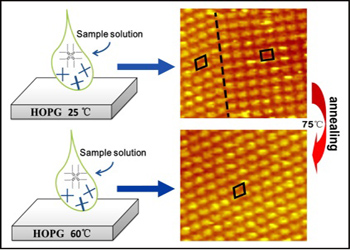
Temperature Dependent 2D Self-assembled Motif Transition of Copper–phthalocyanine Derivates at Air/HOPG Interface: an STM Study
Jul 11, 2014 Email"> PrintText Size

It is known that CuPcOC8 molecules can self-organize on highly oriented pyrolytic graphite and form both quartic symmetry structures with relatively low molecular packing density and hexagonal symmetry structures with high packing density. However, the mechanism of the formation of the two types of molecular adlayers, and the tunability of this metal phthalocyanine film in ambient atmosphere has not been discussed.
Researchers at Xinjiang Technical Institute of Physics & Chemistry (XTIPC) found the transition of the self-assembled structure from quartic to hexagonal symmetry at room temperature. With images obtained by scanning tunnelling microscopy, researchers revealed the existence of an energy barrier between the quartic and the hexagonal structures.
Researchers observed the transition of the self-assembled structure from quartic to hexagonal symmetry by increasing the temperature during the self-assembly process, or applying an annealing treatment to the self-assembled film. It showed that the temperature effect confirmed the existence of the energy barrier between the two types of surface arrangements. Upon increasing the annealing temperature, the thermal energy can be transferred to the adsorbed molecules, providing sufficient kinetic energy to overcome the energy barrier. Since the phase transition can also occur at room temperature, this energy barrier is most probably at the kBT level. The hexagonal phase corresponds to a thermodynamically stable state while the quartic phase is kinetically favorable but thermodynamically metastable. Besides, researchers also found that uniform ordered assembly motifs of CuPcOC8 molecules on a large scale can be obtained with high enough temperature and given enough time.
The results of this study have been published on

The mechanism of irreversible structure transition of CuPcOC8 adlayer from quartic symmetry to hexagonal symmetry at air/HOPG interface (Image by XTIPC)
It is known that CuPcOC8 molecules can self-organize on highly oriented pyrolytic graphite and form both quartic symmetry structures with relatively low molecular packing density and hexagonal symmetry structures with high packing density. However, the mechanism of the formation of the two types of molecular adlayers, and the tunability of this metal phthalocyanine film in ambient atmosphere has not been discussed.
Researchers at Xinjiang Technical Institute of Physics & Chemistry (XTIPC) found the transition of the self-assembled structure from quartic to hexagonal symmetry at room temperature. With images obtained by scanning tunnelling microscopy, researchers revealed the existence of an energy barrier between the quartic and the hexagonal structures.
Researchers observed the transition of the self-assembled structure from quartic to hexagonal symmetry by increasing the temperature during the self-assembly process, or applying an annealing treatment to the self-assembled film. It showed that the temperature effect confirmed the existence of the energy barrier between the two types of surface arrangements. Upon increasing the annealing temperature, the thermal energy can be transferred to the adsorbed molecules, providing sufficient kinetic energy to overcome the energy barrier. Since the phase transition can also occur at room temperature, this energy barrier is most probably at the kBT level. The hexagonal phase corresponds to a thermodynamically stable state while the quartic phase is kinetically favorable but thermodynamically metastable. Besides, researchers also found that uniform ordered assembly motifs of CuPcOC8 molecules on a large scale can be obtained with high enough temperature and given enough time.
The results of this study have been published on

The mechanism of irreversible structure transition of CuPcOC8 adlayer from quartic symmetry to hexagonal symmetry at air/HOPG interface (Image by XTIPC)
CAS Institutes
There are 124 Institutions directly under the CAS by the end of 2012, with 104 research institutes, five universities & supporting organizations, 12 management organizations that consist of the headquarters and branches, and three other units. Moreover, there are 25 legal entities affiliated and 22 CAS invested holding enterprisesThere are 124 I...>> more
Contact Us

Chinese Academy of Sciences
Add: 52 Sanlihe Rd., Xicheng District, Beijing, China
Postcode: 100864
Tel: 86-10-68597592 (day) 86-10-68597289 (night)
Fax: 86-10-68511095 (day) 86-10-68512458 (night)
E-mail: cas_en@cas.cn

